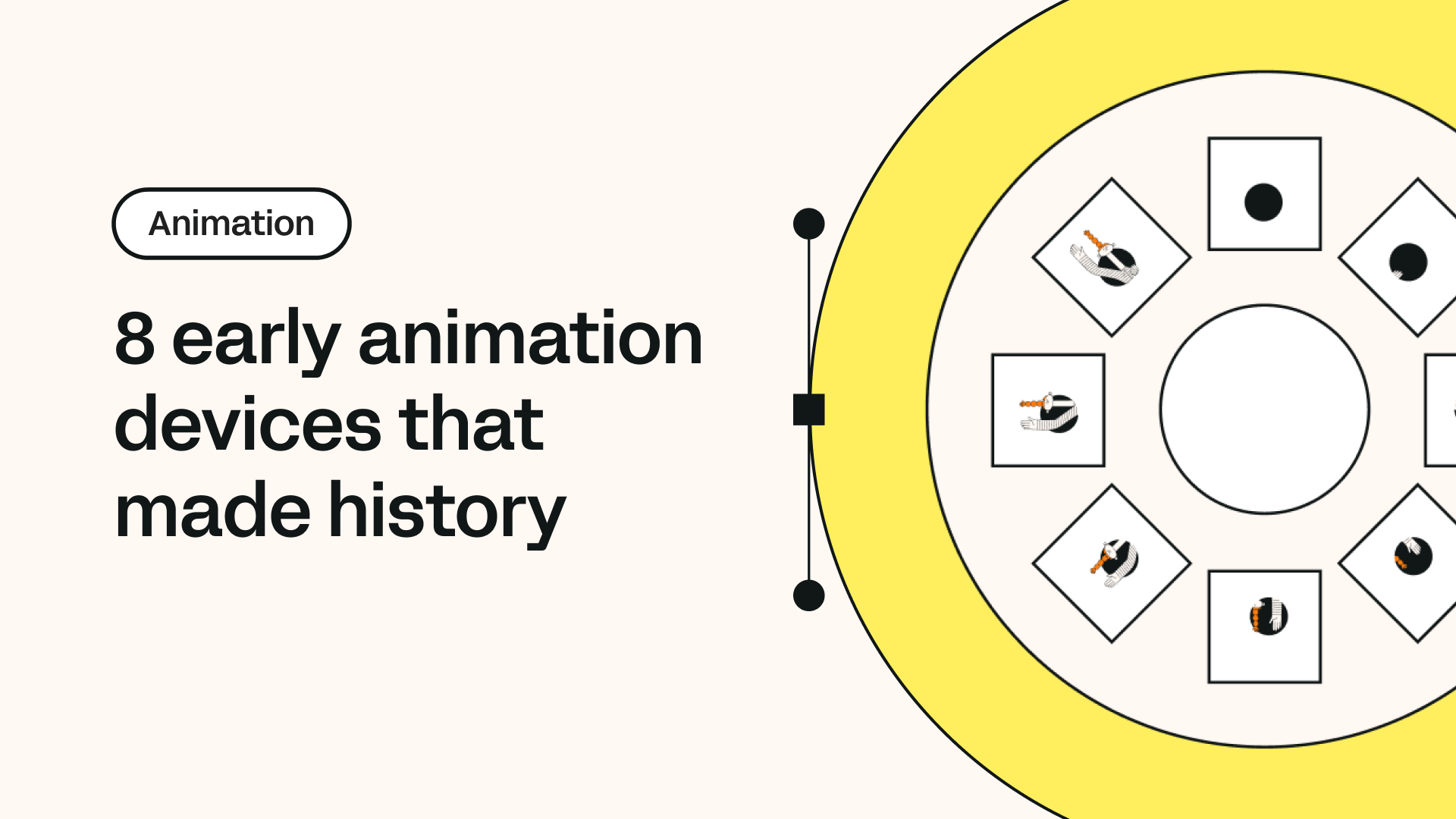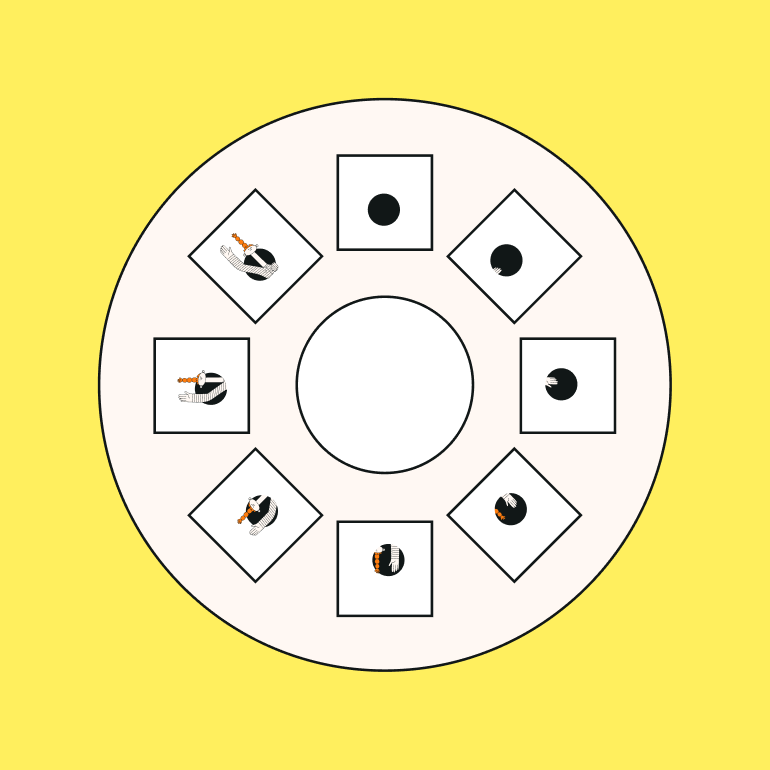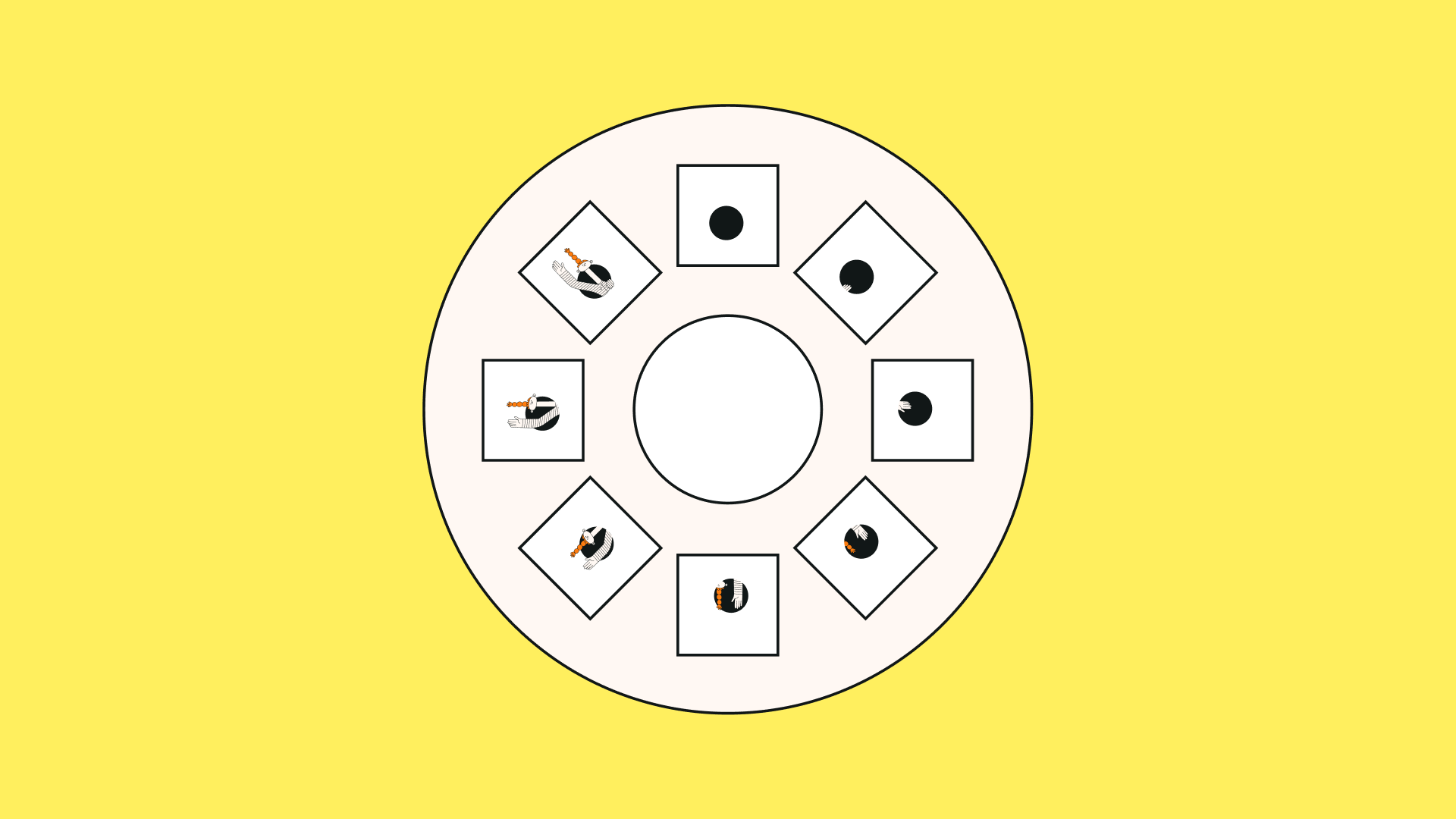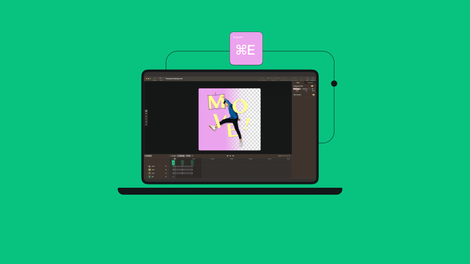Modern animation wouldn’t even exist without these pioneering devices.
Right now, we’re arguably living in a golden age of animation. There are more incredible animated TV shows and films being released than ever before, and if you want to dig into the rich back catalog of animation greats like Studio Ghibli and Walt Disney, streaming platforms have their entire archives available for your binging pleasure. You could say we’re spoiled for choice. But have you ever stopped to think about how we got here?
Jumpstart your ideas with Linearity Curve
Take your designs to the next level.
The history of animation devices
The history of animation is a fascinating journey that relies as much on the way in which animations could be produced as it does on what is actually being animated. Technology is what empowers people to be creative, and animation is a great example of this in practice. As animation devices become more elaborate and develop over time, so do the animations themselves. Here, we take a look at some of the most important animation devices throughout history. So the next time you are enjoying your favorite animated show or movie, just take a second to think about how we got to where we are today.
Magic Lantern (1659)
This is the earliest known animation device on the list, and despite the name, it does not involve rubbing a lantern and having a genie pop out who can then grant you wishes. Rather, the magic lantern is actually an early image projection device and the forerunner of modern projectors. It was created by the Dutch scientist Christiaan Huygens, and interestingly he originally regretted inventing it as he thought it was too frivolous. Thankfully, it made its way out into the world anyway, and over time it evolved and became very popular. If it wasn't for this, the history of animation might have been very different.
It uses a light source (originally a candle), a transparent plate (usually glass) with a picture on it, and a lens. A mirror would direct the light through the glass slides and project the illustration on a flat surface. An adept projectionist could quickly change between slides placed together to give the illusion of movement, so this is actually the earliest ever instance of projected animation. Originally it was a form of entertainment, then it was used for education, and then in the late 19th century it actually became a popular toy.
Thaumatrope (1825)
The name thaumatrope roughly translates from ancient Greek as ‘wonder turner’. It’s a simple little device that consists of a disc with a different image on each side. Popular combinations were a cage on one side and a bird on the other, and a branch on one side and leaves on the other. At either side of the disc is a piece of string, and when the user twists the disc quickly between these two pieces of string, it creates a persistence of vision illusion that makes the two images appear as one. It's a limited animation, but people loved it.
The British physician John Ayrton Paris is widely credited as being the inventor of the thaumatrope, although the mathematician Charles Babbage claimed that it was actually invented by the Irish physician William Henry Fitton. Regardless of who actually invented it, Paris is the person who popularized it through its commercial production in 1825. The boxes of 12 or 18 discs were sold as The Thaumatrope; being Rounds of Amusement or How to Please and Surprise By Turns, which is quite a brilliant name in our opinion for an illusion of motion toy set.
Phenakistoscope (1832)
One of our favorite facts about the phenakistoscope is that it was actually invented by two different people simultaneously. Inspired by the work of English scientist Michael Faraday, the Belgian physicist Joseph Plateau started to experiment with optical illusion as a university student in the late 1820s. This experimentation would eventually lead him to create the phenakistoscope a few years later. At the same time, the Austrian mathematician and inventor Simon von Stampfer was also inspired by the work of Faraday, and he too invented a version of the phenakistoscope, which he named the stroboscope.
A phenakistoscope works in a very simple way, but the effect it produces is super cool. A series of images are drawn onto a cardboard disc, and then slits are cut in the cardboard between each image. A spindle with a handle is then placed through the middle of the disc so that the disc can be easily turned by hand. The tip of the spindle is then placed on a mirror, with the sequence of images facing the mirror. The user then turns the spindle to rapidly spin the cardboard disc, and when the person looks through the slits, the image appears to move as a looping motion animation. The way in which a phenakistoscope tricks your brain is the same way that the frames of a film trick your brain – when successive images appear in quick enough succession, your brain turns the animated feature into one consistently moving image. The phenakistoscope was really popular for around two years before new technological developments blew open the world of animation.
Zoetrope (1833/34)
The zoetrope is essentially a cylindrical version of the phenakistoscope, and uses the same persistence of motion trick to create the illusion of fluid motion. Whereas the phenakistoscope used flat discs, the zoetrope is actually a drum with a series of images on a strip that is placed inside. The images are a series of frames that have incremental changes, just like in modern animation. On the outside of the drum are a number of equally spaced slits. The drum is then spun on its axis, and when the viewer looks through the slits, it looks like the image is moving. It's another good example of early motion animation.
Transform Your Ideas into Animations
Dive into the world of animation with Linearity Move. Perfect for beginners and professionals alike, our course guides you through creating stunning animations for any purpose.
With this change in format there were a number of improvements. First off, whereas you needed a mirror in order for a phenakistoscope, the zoetrope did away with this making it more accessible. Being a cylinder also meant that more than one person at a time could view it. Also, the strips inside the drum were easily interchangeable. The zoetrope was originally developed by British mathematician William George Horner in 1834, but nothing really happened with it for more than thirty years. Then in 1867, the toy company Milton Bradley patented a version of the zoetrope and it became a big hit.
Kineograph AKA The Flipbook (1868)
We absolutely love the fact that the flipbook is technically called a kineograph – it makes it sound so fancy and elaborate. Almost everyone has made their own flipbook in school, and the way in which it works is super simple. You basically draw a sequence of images in a book, and then use your thumb to flick through the pages quickly to create the illusion of motion. Funnily enough, the German word for flipbook is ‘Daumenkino’ which translates to ‘thumb cinema’. When you create your own flipbook, it’s probably the simplest form of hand-drawn animation there is. A flipbook doesn’t need to be hand drawn though – it can be a series of photographs, or printed illustrations. It's a limited animation, but it's also a lot of fun.
@perkolatorpress It’s her first #flipbook and she’s so proud, she wanted me to share it on Tiktok 🥲 #flipbooks #crafts #crafty #poetry #PradaBucketChallenge #fypシ ♬ Mud Flow "the Sense of me" ( Soundtrack Life is Strange) - DOLKINS
No one really knows when the first flip book was invented, and it’s often assumed that it must predate devices like the phenakistoscope, but unfortunately there is no real evidence of this. The first recorded instance of a kineograph comes from 1868, when a patent for it was filed by John Barnes Linnett. Different versions and evolutions of the flip book emerged over the years, such as when it was mechanized as the mutoscope. Early animated filmmakers often say the flipbooks were a source of inspiration. In a nod to the influence of flipbooks, since 2007 Walt Disney has started its films with a production logo sequence that is really reminiscent of a flipbook. What we love about this type of animation is that anyone can do it – just get yourself a blank book and start drawing!
Praxinoscope (1877)
The next iteration in the evolution of animation devices is the praxinoscope. The successor to the zoetrope, the name of the device has its roots in ancient Greek – roughly translating as ‘action viewer’ – and it was invented in 1877 by the French inventor Charles-Emile Reynaud. It’s similar to the zoetrope in the way that it uses the same motion technique and also has a strip of sequential pictures on the inside of a cylinder, but it made a new development that made it a significant improvement on the zoetrope. The praxinoscope did away with the narrow slits that people viewed the animated elements through on the zoetrope and replaced it with an inner circle of mirrors.
When the outer drum containing the strip of pictures was turned rapidly, the image reflected in the mirrors appeared to remain stationary, and the rapid succession of images then gave the illusion of motion to the stationary reflections. Using mirrors instead of narrow slits meant that the resulting image was brighter and less distorted on the praxinoscope than the zoetrope. Reynaud made a number of improvements to the praxinoscope, first the Praxinoscope-Théâtre and then Théâtre-Optique. His devices were responsible for what is considered the first ever projected animated film, making Reynaud a true animation pioneer.
Ready to create powerful animations?
Visit our Academy for free animations courses.
Zoopraxiscope (1879)
The photographic pioneer Edweard Muybridge invented the zoopraxiscope in 1879, and it is now considered an important forerunner to the movie projector. The way Muybridge made this work is kind of incredible, and involves a kind of ‘de-animation’ before a ‘reanimation’. He set up a series of linked cameras to capture animals in motion, and the individual cameras each gave an image of the animal at a different point. These photographs were then animated together using the zoopraxiscope.
The zoopraxiscope consisted of a lantern along with a rotating glass disc. The series of photographs he had taken of animals were then printed onto the glass disc. When the glass discs are rotated in conjunction with a metal shutter disc, it gives the illusion of motion in the same way as a phenakistoscope. This reanimation of his original still photographs is quite ingenious. This was the first time ever that movements had been constructed using photographs from life, which is essentially the same way that modern film works. A total of 71 zoopraxiscope discs are known to have survived.
Theatre Optique (1888)
In 1888, Charles-Emile Reynaud more than one-upped himself when he improved on his original Praxinoscope invention and created the Theatre Optique. Whereas the Praxinoscope only used a single sequence of images on the inside of a cylinder, the Theatre Optique used a long transparent roll of pictures that was wound between two spools. Reynaud himself painted the pictures by hand, and each roll of hand-drawn animation contained between 300 and 700 different frames and could be up to 50 meters in length. These rolls were then wound between two spools, and the images were projected onto a background image. A series of mirrors and magic lanterns were used to make the projections possible, and then Reynaud would operate the device by hand and control the speed of playback.
Reynaud tried to sell his system with the films, and when this didn’t work out he decided to start doing theatrical screenings instead. He ended up showing his animated films at the Musée Grévin in Paris, and between 1892 and 1900 he had huge success performing 12,800 shows to more than 500,000 visitors. The animated films were between 10 and 15 minutes long, and they even included sound effects that were triggered by silver tabs on the roll that activated an electromagnet that would then trigger sounds like a buzzer or drum. The films also had music written especially for them and then played live on the piano, and live dialogue. These are considered the world’s first ever projected animated films and the beginning of the art form. Reynaud was a true animation pioneer, and his method of using a separate motionless background rather than drawing the background into the frame with the moving characters became a staple of cel animation, used by classic cartoons and the animation industry for decades. Without the work of Reynaud, motion pictures may not exist today.
Wrapping up
We hope that you've enjoyed learning about some of the most interesting and influential animation devices in history. Don’t forget to check out our other articles for more insights into the history of animation. And if you haven't joined the waiting list for our our animation tool Linearity Move, what are you waiting for?
Jumpstart your ideas with Linearity Curve
Take your designs to the next level.


Share this!
Adí Aviram
Adí is an SEO developer working for Linearity in Berlin. Her hobbies include drawing comics, yoga, swimming, infinite scrolling, and birdwatching.


:quality(75))
:quality(75))



:quality(75))




